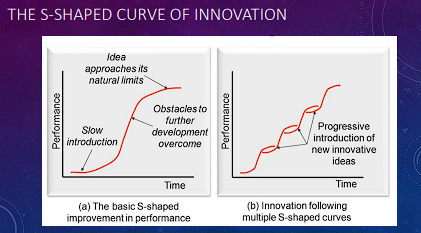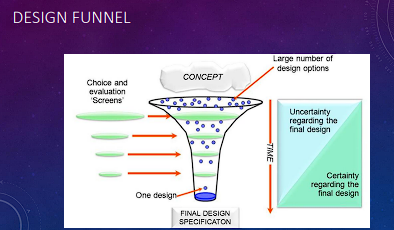
Week 3: Navigating Innovation and Design in Operations Management

Overview:
The concept of the S-shaped curve illustrates the typical lifecycle of an innovative idea in terms of its performance over time.
Details:
Basic S-Shaped Curve (a):
Slow Introduction: New ideas often have a slow start as they face initial resistance or technical challenges.
Rapid Improvement: As adoption increases and the idea is refined, performance improves rapidly.
Natural Limits: Eventually, the idea approaches its inherent limits, where obstacles to further improvement become significant.
Multiple S-Shaped Curves (b):
Represents continuous innovation through the introduction of new ideas, each following its own S-curve. This approach helps overcome the limitations of previous innovations and leads to sustained long-term improvement.

Overview:
The design funnel model visualizes the design process from concept to final product specification, highlighting the narrowing of possibilities and increasing certainty over time.
Details:
Concept Stage: Begins with a large number of potential designs and high uncertainty.
Evaluation and Screening: Through iterative assessments and decision-making, less viable options are systematically eliminated.
Final Design Specification: The process converges on a single, detailed design specification as the most feasible and effective solution, resolving initial uncertainties and solidifying the final design.
Innovation Cycles: Understanding the S-shaped curve can help operations managers anticipate the need for new innovations as current processes reach their performance limits.
Design Process Management: The design funnel underscores the importance of effective decision-making and resource allocation in the early stages of product development to streamline the design process and ensure the successful implementation of operational strategies.

Overview:
The concept of the S-shaped curve illustrates the typical lifecycle of an innovative idea in terms of its performance over time.
Details:
Basic S-Shaped Curve (a):
Slow Introduction: New ideas often have a slow start as they face initial resistance or technical challenges.
Rapid Improvement: As adoption increases and the idea is refined, performance improves rapidly.
Natural Limits: Eventually, the idea approaches its inherent limits, where obstacles to further improvement become significant.
Multiple S-Shaped Curves (b):
Represents continuous innovation through the introduction of new ideas, each following its own S-curve. This approach helps overcome the limitations of previous innovations and leads to sustained long-term improvement.

Overview:
The design funnel model visualizes the design process from concept to final product specification, highlighting the narrowing of possibilities and increasing certainty over time.
Details:
Concept Stage: Begins with a large number of potential designs and high uncertainty.
Evaluation and Screening: Through iterative assessments and decision-making, less viable options are systematically eliminated.
Final Design Specification: The process converges on a single, detailed design specification as the most feasible and effective solution, resolving initial uncertainties and solidifying the final design.
Innovation Cycles: Understanding the S-shaped curve can help operations managers anticipate the need for new innovations as current processes reach their performance limits.
Design Process Management: The design funnel underscores the importance of effective decision-making and resource allocation in the early stages of product development to streamline the design process and ensure the successful implementation of operational strategies.